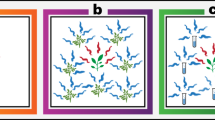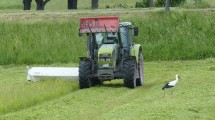Abstract
Studies of odour-driven foraging by mammals focus on attractant cues emitted by flowers, fruits, and fungi. Yet, the leaves of many plant species worldwide produce odour, which could act as a cue for foraging mammalian herbivores. Leaf odour may thus improve foraging efficiency for such herbivores in many ecosystems by reducing search time, particularly but not only, for plants that are visually obscured. We tested the use of leaf odour by a free-ranging mammalian browser, the swamp wallaby (Wallabia bicolor) to find and browse palatable tree seedlings (Eucalyptus pilularis). Wallabies visited patches non-randomly with respect to the presence of seedlings. In the absence of visual plant cues, they used leaf odour (cut seedlings in vials) to find patches earlier, and visited and investigated them more often than control patches (empty vials), supporting the hypothesis that wallabies used seedling odour to enhance search efficiency. In contrast, the grey kangaroo (Macropus giganteus), a grazer, showed no response to seedling odour. When the availability of seedling visual and olfactory cues was manipulated, wallabies browsed seedlings equally quickly in all treatments: upright (normal cues), pinned to the ground (reduced visual cues), and upright plus pinned seedlings (double olfactory cues). Odour cues play a critical role in food-finding by swamp wallabies, and these animals are finely tuned to detecting these cues with their threshold for detection reached by odours from only a single plant. The global significance of leaf odour in foraging by mammalian herbivores consuming conifers, eucalypts, and other odour-rich species requires greater attention.




Similar content being viewed by others
References
Asahina K, Pavlenkovich V, Vosshall LB (2008) The survival advantage of olfaction in a competitive environment. Curr Biol 18:1153–1155. doi:10.1016/j.cub.2008.06.075
Augustine DJ, McNaughton SJ (1998) Ungulate effects on the functional species composition of plant communities: herbivore selectivity and plant tolerance. J Wildl Manag 62:1165–1183
Baldwin IT (2010) Plant volatiles. Curr Biol 20:R392–R397. doi:10.1016/j.cub.2010.02.052
Bedoya-Pérez MA, Isler I, Banks PB, McArthur C (2014) Roles of the volatile terpene, 1,8-cineole, in plant–herbivore interactions: a foraging odor cue as well as a toxin? Oecologia 174:827–837. doi:10.1007/s00442-013-2801-x
Bukovinszky T, Potting RPJ, Clough Y, Van Lenteren JC, Vet LEM (2005) The role of pre- and post-alighting detection mechanisms in the responses to patch size by specialist herbivores. Oikos 109:435–446. doi:10.1111/j.0030-1299.2005.13707.x
Close DC, Davidson NJ (2003) Revegetation to combat tree decline in the Midlands and Derwent Valley Lowlands of Tasmania: practices for improved plant establishment. Ecol Manag Restor 4:29–36. doi:10.1046/j.1442-8903.2003.00135.x
Cool LG, Zavarin E (1992) Terpene variability of mainland Pinus radiata. Biochem Syst Ecol 20:133–144. doi:10.1016/0305-1978(92)90100-R
Côté SD, Rooney TP, Tremblay J-P, Dussault C, Waller DM (2004) Ecological impacts of deer overabundance. Annu Rev Ecol Evol Syst 35:113–147. doi:10.1146/annurev.ecolsys.35.021103.105725
Davis NE, Coulson G, Forsyth DM (2008) Diets of native and introduced mammalian herbivores in shrub-encroached grassy woodland, south-eastern Australia. Wildl Res 35:684–694. doi:10.1071/WR08042
Dearing MD, Foley WJ, McLean S (2005) The influence of plant secondary metabolites on the nutritional ecology of herbivorous terrestrial vertebrates. Annu Rev Ecol Evol Syst 36:169–189. doi:10.2307/30033801
Dexter N, Ramsey DSL, MacGregor C, Lindenmayer D (2012) Predicting ecosystem wide impacts of wallaby management using a fuzzy cognitive map. Ecosystems 15:1363–1379. doi:10.1007/s10021-012-9590-7
Dexter N, Hudson M, James S, MacGregor C, Lindenmayer DB (2013) Unintended consequences of invasive predator control in an Australian forest: overabundant wallabies and vegetation change. PLoS One 8:e69087. doi:10.1371/journal.pone.0069087
Doty RL (1986) Odor-guided behavior in mammals. Experientia 42:257–271. doi:10.1007/bf01942506
Duncan AJ, Hartley SE, Iason GR (1994) The effect of monoterpene concentrations in Sitka spruce (Picea sitchensis) on the browsing behaviour of red deer (Cervus elaphus). Can J Zool 72:1715–1720. doi:10.1139/z94-231
Ehrlich PR, Raven PH (1964) Butterflies and plants—a study in coevolution. Evolution 18:586–608. doi:10.2307/2406212
Foley WJ, Iason GR, McArthur C (1999) Role of plant secondary metabolites in the nutritional ecology of mammalian herbivores: how far have we come in 25 years? In: Jung H-J, Fahey G (eds) Nutritional ecology of herbivores: proceedings of the Vth International Symposium on the Nutrition of Herbivores. American Society of Animal Science, Savoy, pp 130–209
Fraenkel GS (1959) The raison d’être of secondary plant substances. Science 129:1466–1470. doi:10.2307/1756998
Glendinning JI (2007) How do predators cope with chemically defended foods? Biol Bull 213:252–266
Goheen JR, Keesing F, Allan BF, Ogada D, Ostfeld RS (2004) Net effects of large mammals on Acacia seedling survival in an African savanna. Ecology 85:1555–1561. doi:10.1890/03-3060
Halitschke R, Stenberg JA, Kessler D, Kessler A, Baldwin IT (2008) Shared signals—alarm calls’ from plants increase apparency to herbivores and their enemies in nature. Ecol Lett 11:24–34. doi:10.1111/j.1461-0248.2007.01123.x
Hanley ME, Sykes RJ (2009) Impacts of seedling herbivory on plant competition and implications for species coexistence. Ann Bot 103:1347–1353. doi:10.1093/aob/mcp081
Hanley ME, Girling RD, Felix AE, Olliff ED, Newland PL, Poppy GM (2013) Olfactory selection of Plantago lanceolata by snails declines with seedling age. Ann Bot 112:671–676. doi:10.1093/aob/mct003
Henery ML, Wallis IR, Stone C, Foley WJ (2008) Methyl jasmonate does not induce changes in Eucalyptus grandis leaves that alter the effect of constitutive defences on larvae of a specialist herbivore. Oecologia 156:847–859. doi:10.1007/s00442-008-1042-x
Hoballah M, Stuurman J, Turlings TJ, Guerin P, Connétable S, Kuhlemeier C (2005) The composition and timing of flower odour emission by wild Petunia axillaris coincide with the antennal perception and nocturnal activity of the pollinator Manduca sexta. Planta 222:141–150. doi:10.1007/s00425-005-1506-8
Hodgkison R et al (2007) Chemical ecology of fruit bat foraging behavior in relation to the fruit odors of two species of paleotropical bat-dispersed figs (Ficus hispida and Ficus scortechinii). J Chem Ecol 33:2097–2110. doi:10.1007/s10886-007-9367-1
Kohl KD, Miller AW, Dearing MD (2015) Evolutionary irony: evidence that ‘defensive’ plant spines act as a proximate cue to attract a mammalian herbivore. Oikos 124:835–841. doi:10.1111/oik.02004
Langenheim JH (1994) Higher plant terpenoids: a phytocentric overview of their ecological roles. J Chem Ecol 20:1223–1280. doi:10.1007/bf02059809
Lawler IR, Stapley J, Foley WJ, Eschler BM (1999) Ecological example of conditioned flavor aversion in plant–herbivore interactions: effect of terpenes of Eucalyptus leaves on feeding by common ringtail and brushtail possums. J Chem Ecol 25:401–415. doi:10.1023/A:1020863216892
Low PA, McArthur C, Fisher K, Hochuli DF (2014) Elevated volatile concentrations in high-nutrient plants: do insect herbivores pay a high price for good food? Ecol Entomol 39:480–491. doi:10.1111/een.12124
McArthur C, Hagerman AE, Robbins CT (1991) Physiological strategies of mammalian herbivores against plant defenses. In: Palo RT, Robbins CT (eds) Plant defenses against mammalian herbivory. CRC Press, Boca Raton, pp 103–114
Molangui T, Menut C, Bouchet P, Bessière J-M, Habimana J-B (1997) Aromatic plants of tropical Central Africa. Part XXX. Studies on volatile leaf oils of 10 species of Eucalyptus naturalized in Rwanda. Flavour Fragr J 12:433–437. doi:10.1002/(sici)1099-1026(199711/12)12:6<433:aid-ffj668>3.0.co;2-r
Moles AT, Westoby M (2004) What do seedlings die from and what are the implications for evolution of seed size? Oikos 106:193–199. doi:10.1111/j.0030-1299.2004.13101.x
Pallini A, Janssen A, Sabelis MW (1997) Odour-mediated responses of phytophagous mites to conspecific and heterospecific competitors. Oecologia 110:179–185. doi:10.1007/s004420050147
Peñuelas J, Llusià J (2004) Plant VOC emissions: making use of the unavoidable. Trends Ecol Evol 19:402–404. doi:10.1016/j.tree.2004.06.002
Plotnik JM, Shaw RC, Brubaker DL, Tiller LN, Clayton NS (2014) Thinking with their trunks: elephants use smell but not sound to locate food and exclude nonrewarding alternatives. Anim Behav 88:91–98. doi:10.1016/j.anbehav.2013.11.011
Pollock ML, Milner JM, Waterhouse A, Holland JP, Legg CJ (2005) Impacts of livestock in regenerating upland birch woodlands in Scotland. Biol Conserv 123:443–452. doi:10.1016/j.biocon.2005.01.006
Provenza FD, Pfister JA, Cheney CD (1992) Mechanisms of learning in diet selection with reference to phytotoxicosis in herbivores. J Range Manag 45:36–45. doi:10.2307/4002523
Rapley L, Allen G, Potts B, Davies N (2007) Constitutive or induced defences—how does Eucalyptus globulus defend itself from larval feeding? Chemoecology 17:235–243. doi:10.1007/s00049-007-0382-z
Reichardt PB, Bryant JP, Mattes BR, Clausen TP, Chapin FS III, Meyer M (1990) Winter chemical defense of Alaskan balsam poplar against snowshoe hares. J Chem Ecol 16:1941–1959. doi:10.1007/bf01020507
Ripple WJ, Beschta RL (2003) Wolf reintroduction, predation risk, and cottonwood recovery in Yellowstone National Park. For Ecol Manag 184:299–313. doi:10.1016/s0378-1127(03)00154-3
Schaefer HM, Ruxton GD (2011) Plant–animal communication. Oxford University Press, Oxford
Shao M et al (2001) Volatile organic compound emissions from Scots pine: mechanisms and description by algorithms. J Geophys Res Atmos 106:20483–20491. doi:10.1029/2000JD000248
Snyder MA (1992) Selective herbivory by Abert’s squirrel mediated by chemical variability in ponderosa pine. Ecology 73:1730–1741. doi:10.2307/1940025
Stowe MK, Turlings TC, Loughrin JH, Lewis WJ, Tumlinson JH (1995) The chemistry of eavesdropping, alarm, and deceit. Proc Natl Acad Sci 92:23–28
Stutz RS, Banks PB, Dexter N, McArthur C (2015a) Associational refuge in practice: can existing vegetation facilitate woodland restoration? Oikos 124:571–580. doi:10.1111/oik.01782
Stutz RS, Banks PB, Dexter N, McArthur C (2015b) Herbivore search behaviour drives associational plant refuge. Acta Oecol 67:1–7. doi:10.1016/j.actao.2015.05.004
Unsicker SB, Kunert G, Gershenzon J (2009) Protective perfumes: the role of vegetative volatiles in plant defense against herbivores. Curr Opin Plant Biol 12:479–485
Vas G, Vékey K (2004) Solid-phase microextraction: a powerful sample preparation tool prior to mass spectrometric analysis. J Mass Spectrom 39:233–254. doi:10.1002/jms.606
Vuorinen T, Nerg A-M, Vapaavuori E, Holopainen JK (2005) Emission of volatile organic compounds from two silver birch (Betula pendula Roth) clones grown under ambient and elevated CO 2 and different O 3 concentrations. Atmos Env 39:1185–1197. doi:10.1016/j.atmosenv.2004.09.077
Wahungu GM, Catterall CP, Olsen MF (1999) Selective herbivory by red-necked pademelon Thylogale thetis at rainforest margins: factors affecting predation rates. Aust J Ecol 24:577–586. doi:10.1046/j.1442-9993.1999.01005.x
Acknowledgments
Booderee National Park provided accommodation and resources; we particularly thank Nicholas Dexter and Stig Pedersen for supporting the project. RSS received an Australian Postgraduate Award and the research was supported by the University of Sydney. The authors declare that they have no conflict of interest. The University of Sydney Animal Ethics Committee approved all procedures (L04/2-2012/3/5696). All research was conducted under a National Parks Permit (BDR12/00001).
Author contribution statement
RSS, PBB and CM conceived and designed the field experiments; RSS and NP designed the laboratory protocol. RSS performed the experiments and analysed the data. RSS and CM wrote the manuscript; PBB and NP provided editorial advice.
Author information
Authors and Affiliations
Corresponding author
Additional information
Communicated by Carlos L. Ballare.
Browsing has significant effects on plant communities yet little is known about how mammals find foliage. We demonstrate for the first time that odour is an important food cue for a browsing mammal.
Electronic supplementary material
Below is the link to the electronic supplementary material.
Rights and permissions
About this article
Cite this article
Stutz, R.S., Banks, P.B., Proschogo, N. et al. Follow your nose: leaf odour as an important foraging cue for mammalian herbivores. Oecologia 182, 643–651 (2016). https://doi.org/10.1007/s00442-016-3678-2
Received:
Accepted:
Published:
Issue Date:
DOI: https://doi.org/10.1007/s00442-016-3678-2




